Women’s History Month
To mark Women’s History Month we’re celebrating by highlighting a selection of women inventors from history.

There are many (although not enough) examples of great women in history overcoming many challenges and becoming the first in their field. They fought for inclusion, and later equality, paving the way for the following generations to help create the world we now know.
This includes our very own Edinburgh Seven, several scientists such as the famous Marie Curie and the many women in telecommunications research and roles as ‘computers’ for various organisations including NASA. However, for the purposes of this guide, we’re focusing on inventors and business owners.
Here are five women inventors from history:
Madam C.J. Walker
1867 – 1919
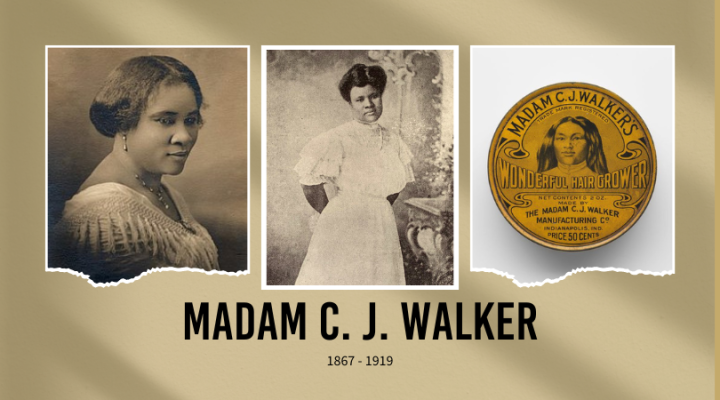
First women self-made millionaire in America
Entrepreneur, philanthropist and political and social activist.
Born Sarah Breedlove, close to Delta, Louisiana and one of six children. Her older siblings were enslaved by Robert W. Burney on his Madison Parish plantation. Sarah was the first child born in her family born into freedom after the Emancipation Proclamation was signed.
Recorded as the first female self-made millionaire in America (although other women are documented who might have been the first, their wealth is not as well-documented). Walker made her fortune by developing and marketing a line of cosmetics and hair care products for black women.
Founder of the Madam C.J. Walker Manufacturing Company. She became known for her philanthropy and activism. She made financial donations to numerous organisations a patron of the arts. Villa Lewaro, Walker’s lavish estate in Irvington, New York, served as a social gathering place for the African-American community. At the time of her death, she was considered the wealthiest African-American businesswoman and wealthiest self-made black woman in America.
Josephine Cochrane
1839 – 1913
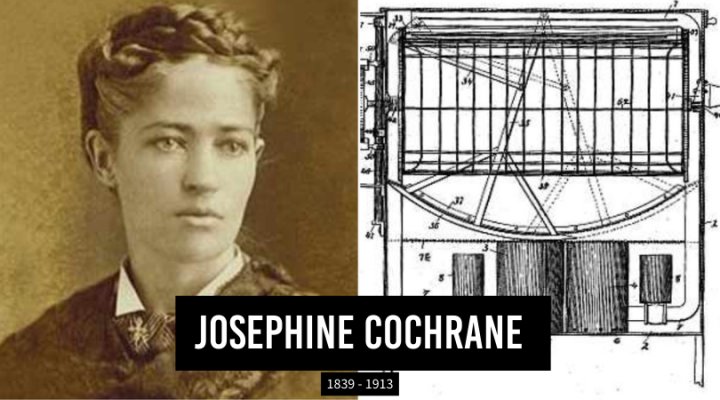
First successful hand-powered dishwasher
First successful hand-powered dishwasher which Cochrane designed, and then constructed with the assistance of mechanic George Butters, who become one of her first employees.
Once the patent was issued on 28th December 1886, Cochrane founded Garis-Cochrane Manufacturing Company to manufacture her machines. Cochran showed her new machine at the World’s Columbian Exposition in Chicago in 1893 where 9 Garis-Cochrane washers were installed in the restaurants and pavilions of the Fair and was met with interest from restaurants and hotels, where hot water access was not an issue. Cochrane won the prize for “best mechanical construction, durability and adaptation to its line of work” at the Fair. Garis-Cochrane Manufacturing Company, which built dishwashers, grew through a focus on hotels and other commercial customers.
Cochran’s Crescent Washing Machine Company became part of KitchenAid through acquisition by Hobart Manufacturing Company after Cochran’s death in 1913. Cochran was posthumously inducted into the National Investors Hall of Fame in 2006 for her invention of the dishwasher.
Mary Anderson
1866 – 1953
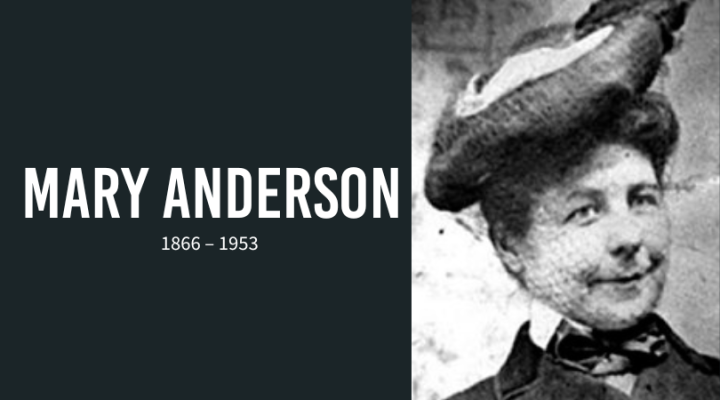
Inventor of the windshield wiper blade
Mary Elizabeth Anderson was a real estate developer, rancher, viticulturist and inventor of the windshield wiper blade. On 10th November 1903 Anderson was granted the first patent for an automatic car window cleaning device controlled from inside the car, called the windshield wiper.
In Birmingham, Alabama, Anderson became a real estate developer soon after settling and built the Fairmont Apartments on Highland Avenue. In 1893 she left to operate a cattle ranch and vineyard in Fresno, California.
In a visit to New York City in the winter of 1902, while sat in a trolley car on a frosty day she observed the driver had to open the window, lean out or stop the car to go outside and wipe the windscreen to clear it. Anderson identified the problem and opportunity.
When she returned to Alabama she hired a designer for a hand-operated device to keep a windshield clear and had a local company produce a working model. She applied for, and in 1903, was granted, a 17-year patent for windshield wiper.
Her design consisted of a level inside the vehicle that controlled a rubber blade on the outside of the windshield. The lever could be operated to cause a spring-loaded arm to move back and forth across the windshield and even removed when not needed. Similar devices had been made earlier, but Anderson’s was the first to be effective.
By 1913 the automobile manufacturing business had grown exponentially, and windshield wipers were standard equipment. In 1922 Cadillac become the first car manufacturer to adopt them as standard equipment. However, Anderson never profited from her invention, the patent expiring in 1920.
Beulah Louise Henry
1866 – 1953
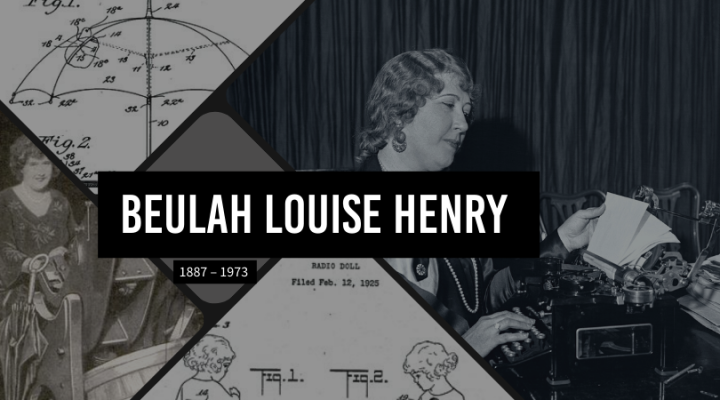
Known for 110 inventions and 49 patents
An inventor nicknamed “Lady Edison” for her many inventions. According to the Journal of the Patent Office Society, in 1937, she was known as “America’s leading feminine inventor”. Famed for being a prolific inventor, Henry patented a wide number of products and innovations designed to improve daily life. Her work was so well known and respected that, as of 1937, she had a museum exhibit dedicated to her in Osaka, Japan, which was seen as an inspiration to aspiring female Japanese inventors.
In her early careers she moved to New York in 1924 where she founded two companies. She worked as an inventor for the Nicholas Machine Works from 1939 – 1955 and consulted for many companies that manufactured her inventions.
Her inventions include a bobbin-free sewing machine and a vacuum ice cream freezer. She received 49 patents and had around 110 inventions in total.
Other inventions:
- Hair curler
- Vanity case
- Rubber sponge soap holder
- Snap-on parasol – which would allow women to change the pattern of their parasol to match their outfit
- Invented a new way to stuff dolls
- Movable eye structure for figure toys
- Protograph - a tool that enabled the writing of multiple copies of a document on a typewriter without the use of carbon paper
- Can opener
- Foot covering
Maria E. Beasley
1836 – 1913
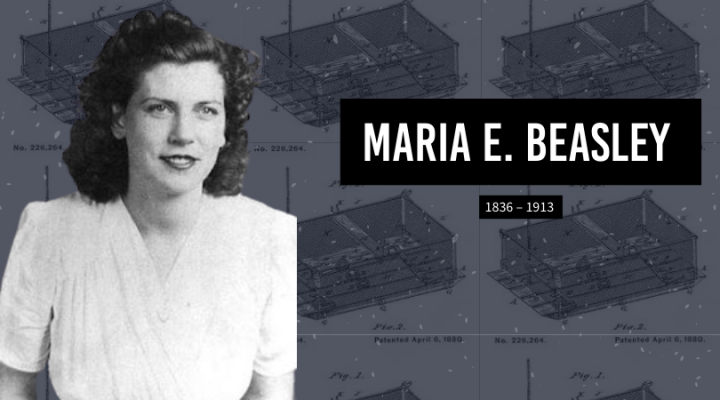
Entrepreneur and inventor
Between 1978 and 1898 she patented 15 inventions including a footwarmer, an improved life raft and an anti-derailment device for trains, however her primary success as an inventor rose from a speciality in barrel-making machines and processes.
Beasley licensed a patent to the Standard Oil Company, exhibited her work at the World’s Industrial and Cotton Centennial Exposition and the World’s Columbian Exposition and founded two companies for the design and manufacture of barrels. One of which later sold for $1.4 million, the equivalent to over $42 million as of 2021.
Barrel-hooping machine
Previously all barrels were made by hand and in 1881 Beasley won her first patent for a barrel-hooping machine. He machine is designed to fit hoops tightly onto both sides of the barrel, the final design was capable of hooping 1,600-1,700 barrels per day, far more than a barrel cooper would be able to do manually. Aside from her two barrel-hooping process Beasley also patented at least 5 other barrel-related innovations including a process of making barrels and a process for notching and cutting hoops.
Life raft design
Beasley was awarded 2 patents for an improved life raft, one in 1880 and the other in 1882. Beasley’s raft uses a base of collapsible metal floats that is more flexible and makes storage on aboard a ship easier, also including airtight containers to protect perishable provisions.
Join Power Her Up today!
Only 1 in 3 UK entrepreneurs is female. A gender gap equivalent to 1.1 million missing businesses. Women are less likely to believe they possess entrepreneurial skills: Only 39% of women are confident in their capabilities to start a business compared to 55% of men. This is a perceived gap in ability, rather than an actual gap in skill sets. (Rose Review of Female Entrepreneurship, HM Treasury 2019).
That's why we created Power Her Up, a support programme designed to empower those students and recent graduates who identify as female to succeed.
Find out more and book onto a Power Her Up event now
This talk might have been one of the best things I have ever been to at the University and I’ve been here for 3 years! It was so, so informative and inspiring.

